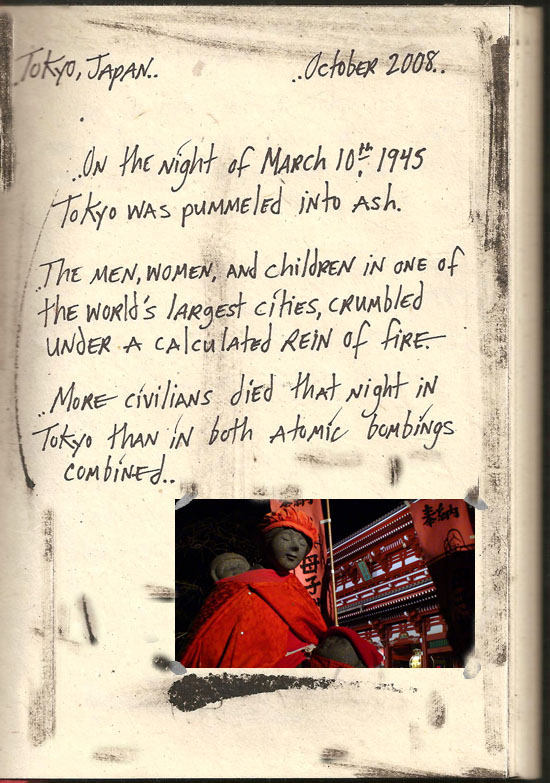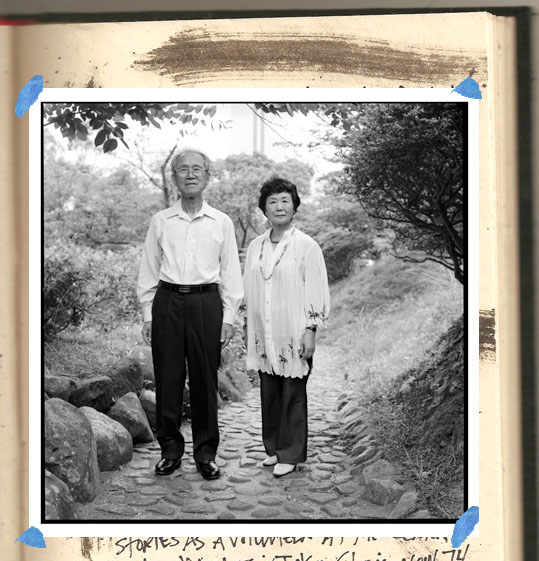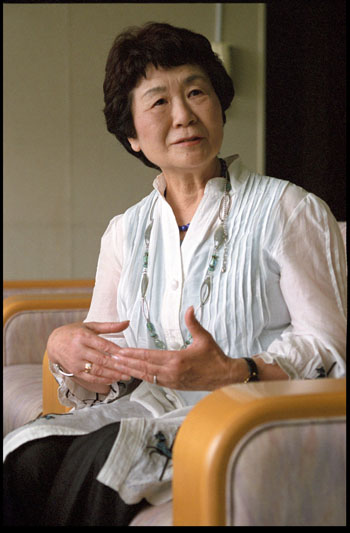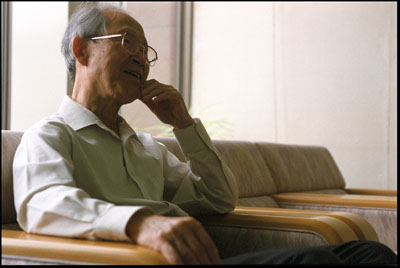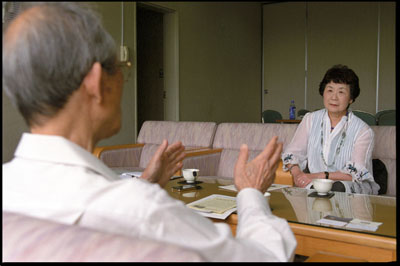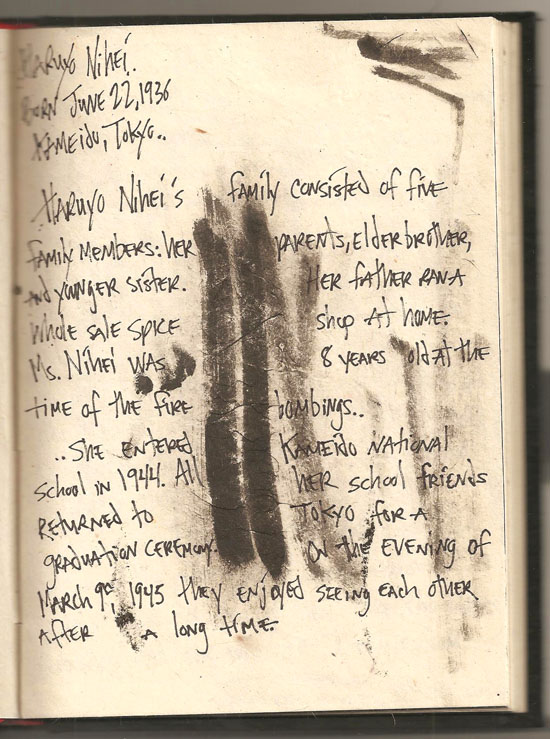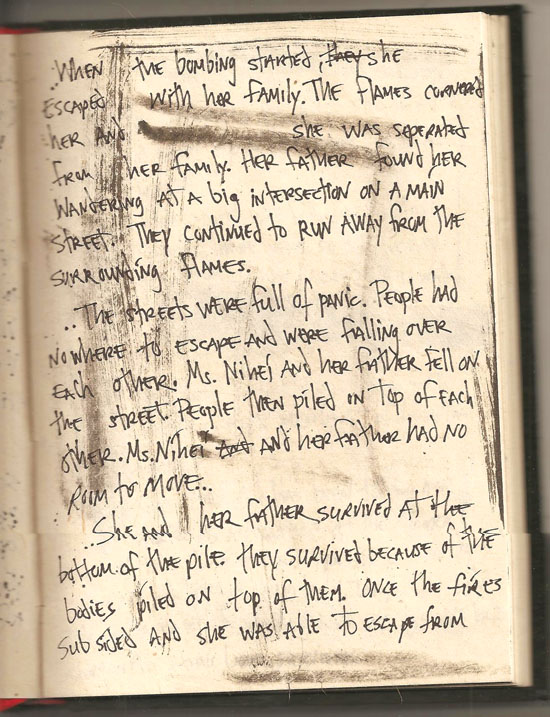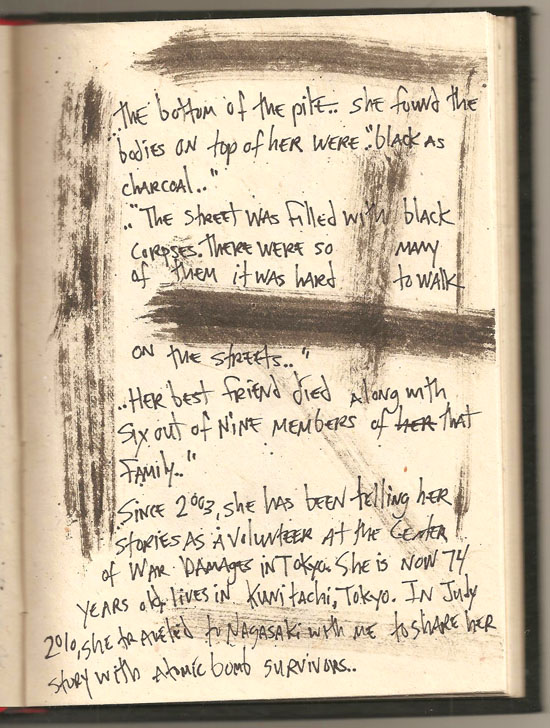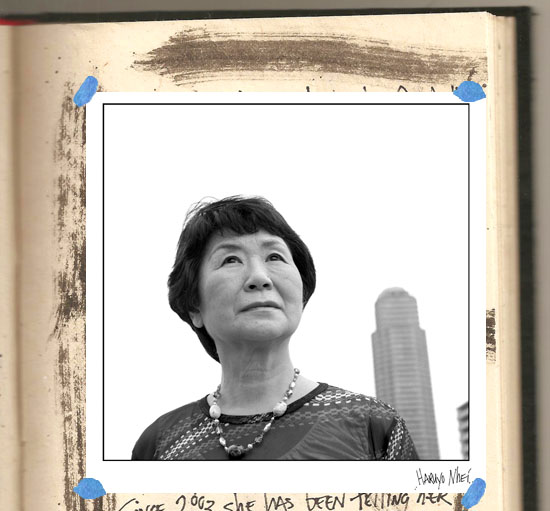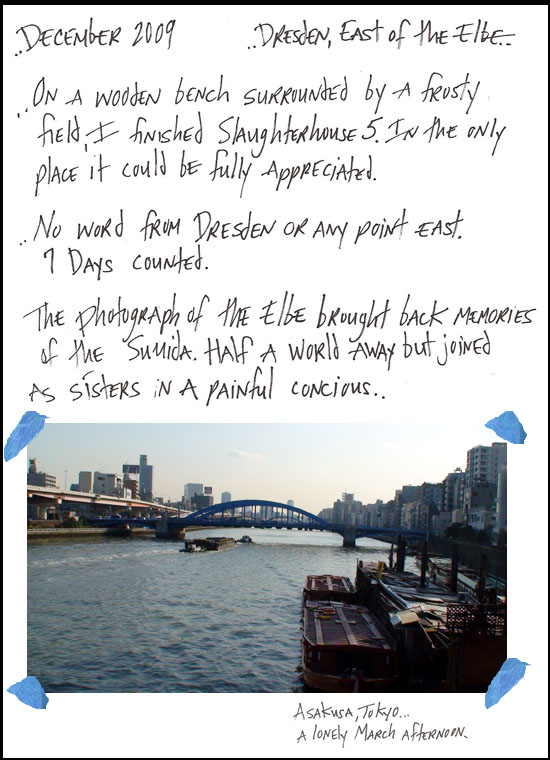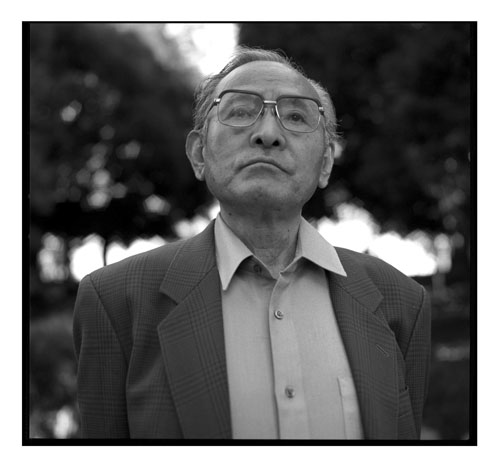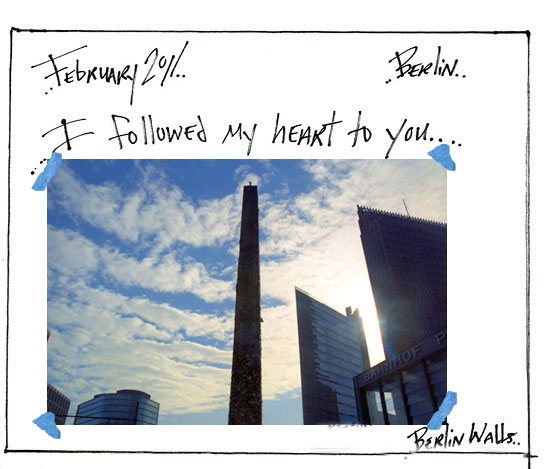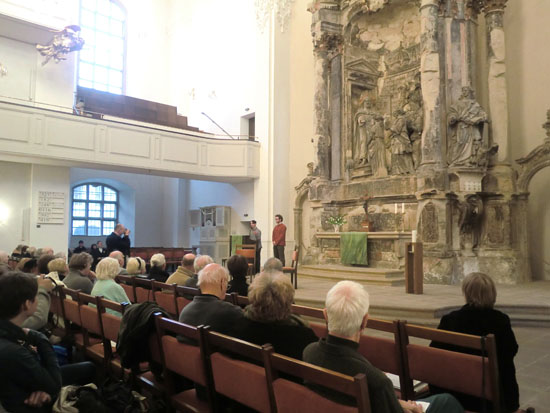Archive for March, 2011
March 10th, 1945 Tokyo fire bombings
Wednesday, March 9th, 2011Hibakusha, atomic bomb Survivor, Mr. Masatoshi Tsunenari and Tokyo fire bombing Survivor Ms. Haruyo Nihei
Tuesday, March 8th, 2011..June 2010..
Hibakusha, atomic bomb Survivor, Mr. Masatoshi Tsunenari and Tokyo fire bombing Survivor Ms. Haruyo Nihei a block away from the epicenter where the atomic bomb was detonated in Nagasaki.
Ms. Haruyo Nihei, a Tokyo fire bombing Survivor I photographed for the original From Above series, accompanied the exhibition when it was shown at the Nagasaki Peace Museum during June/July 2010. She wanted to tell her story of surviving the 3/10 fire bombing of Tokyo to an atomic bomb Survivor.
Hibakusha Mr. Tsunenari agreed meet Ms. Nihei in Nagasaki. It was an amazing moment to see them listen and exchange stories. Tragic moments in time that changed their lives instantly.
It was the highlight of my trip to Nagasaki. I was proud the exhibition was shown at the Nagasaki Peace Museum. But to see the feelings of Ms. Nihei, it’s what I want From Above to be about. A project that eclipses my photos and allows others to reach out to one another. Seeing Mr. Tsunenari listen to and accept Ms. Nihei’s story of the 3/10 Tokyo fire bombings was moving. I believe it was a great feeling of relief to Ms. Nihei to be able to share her story.
Many of the 3/10 Survivors don’t get the recognition as others. The event is swept away as a side note in the history books and society. On March 10, 1945 more people died in Tokyo, during one night, than in both atomic bombings combined.
Ms. Haruyo Nihei
Monday, March 7th, 2011East of the Elbe, half a world away from the Sumida
Sunday, March 6th, 2011Mr. Matashichi Oishi, former crew member of Lucky Dragon 5, Bikini Atoll Hibakusha
Thursday, March 3rd, 2011March 1, 1954….
Matashichi Oishi
Born 1934 in Shizuoka, Japan
Mr. Matashichi Oishi is a former crew member of the Daigo Fukuryu-Maru (Lucky Dragon 5), tuna fishing boat. He turned 20 years old on the second day of the journey from Yaizu harbor to Marshall Islands. Due to the postwar food shortages, they had to sail farther distances to catch fish. The boat trip from central Japan to the Marshall Islands took over 2 weeks, one way.
There were 23 crew members on the wooden boat. Average age was 25 years old. In the early morning of March 1st, 1954, the boat was exposed to radiation by a hydrogen bomb nuclear test at the Bikini Atoll. It was an unannounced secret test. They were fishing 160km away from the hypocenter.
The bomb was 1,000 times more powerful than the atomic bomb detonated in Hiroshima. It contained 270 different kinds of radioactive materials.
Mr. Oishi saw a strong flash of light. An orange color soaked the sky. After 7 minutes they heard horrific rumbling. Strangely, the sea surface stayed calm. They were frightened and decided to return.
They had to raise the fishing nets and long fishing lines from the deep water. This took hours to complete. Soon after “ashes of death”(nuclear fallout) started falling, covering the boat like snow. They had no idea what it was, some licked the flakes. The flakes of ash didn’t melt, felt like sand, and burned their skin.
They removed the fishing nets and long fishing lines while the radioactive ashes fell. It took 5 hours to get the equipment to the surface so they could begin their voyage home.
After a 2 week journey, they arrive at Yaizu harbor. All of them already suffered from acute radiation diseases such as dizziness, loss of appetite, gum bleeding, diarrhea, vomiting, and hair loss. But they still didn’t know what they were exposed to.
A newspaper released the news about the nuclear test. It caused a panic in Japan. “Poisoned fishermen brought back poisoned tuna.” Even rain contaminated with radioactivity feel over Japan and other countries in the Pacific Ocean.
The panic created an anti-nuclear movement and encouraged Hiroshima and Nagasaki atomic bomb Survivors to speak about their experiences. Nearly 10 years after the bombings in Hiroshima and Nagasaki, this was the first public discussion about nuclear weapons in Japan.
During the American Occupation after WW II, news about the atomic bombings in Hiroshima and Nagasaki was censored. The American government allowed no public discussion or articles in Japan to be written about the bombings. The official reason given, as a precaution of the Cold War they didn’t want the USSR to gain information about the affects or material used. Because of the censorship the Japanese public, outside of Hiroshima and Nagasaki, were largely unaware about the affects of radioactivity.
The Lucky Dragon 5 event was covered up in negotiations between the US and Japanese governments. The boat was painted over and dumped in a landfill in Tokyo. The ill fishermen were abandoned and outcast socially. Their lives changed completely. They didn’t have visible burn or scar but inside their bodies were radioactively contaminated. All battled various types of cancers throughout their lives. The first member of the crew died a half year later. More than half of the crew has died. All of them died from liver cancer.
Mr. Oishi has also suffered for varied aftereffects; including liver cancer and social discrimination. The company and government have claimed no responsibility for his health care bills even though he was exposed while working.
After 30 years of silence, he started to speak about his experiences. He is one of only two voices out of 23 Lucky Dragon crew members to speak. 856 boats, containing 17,000 Japanese fishermen, were present in the marine area the day of the nuclear test at Bikini Atoll. None of the others have chosen to speak or release their medical records
Mr. Oishi is photographed at the location were the Lucky Dragon 5 was found. The discarded boat was discovered in 1967. The boat has since been persevered and a museum has been built around it.
Fragile
Wednesday, March 2nd, 2011Speech at the Dreikönigskirche in Dresden on February 11, 2011
Tuesday, March 1st, 2011..February 2011.. ..Dresden..
The text from my speech given at the Dreikönigskirche in Dresden on February 11, 2011.
I was asked to speak about the From Above project while it was exhibited in Dresden for the commemorations of the fire bombings. The Dreikönigskirche was completely destroyed during the fire bombings. But was rebuilt. The surviving and heavy damaged altar is inside the rebuilt church.
Paule Saviano, February 11, 2011……
In a time when it seems people have not learned that war is not a rational way to resolve disagreements, I’m proud to be in Dresden to support the survivors of the Dresden fire bombings and to inform my generation that war only causes suffering.
My name is Paule Saviano. I’m a photographer New York. My journey to Dresden started with my photography project about atomic bomb survivors from Hiroshima and Nagasaki and Tokyo fire bombing survivors. In Japan, I have met 40 atomic bomb survivors in 3 years.
Around his time last year, I wrote a letter to Nora Lang asking to come to Dresden to extend my project. In May 2010, I traveled to Dresden and met 12 fire bombing Survivors. Many are in the audience today.
I’m very pleased to be back in Dresden. My experience in Dresden and Japan has been an education. Every time I met a war survivor, I realize how fortunate I’ve been not to have experienced war.
I realize how fragile life is. Each person I met in Dresden and Japan has been welcoming and inspiring. They demonstrate incredible courage and honesty speaking about experiences that changed their lives forever. I’ve been fortunate enough to spend time with each one of these people. These conversations have been the foundations for new friendships that transcend generational and ethnic differences. It has put a voice and face to words in history books. Most people view war with statistics and dates. They forget war affects real people. The voices and faces of ordinary people are neglected in history books. I have been able to find these voices with my project.
Each day I think about everyone I‘ve photographed in Dresden and Japan. They have encouraged me to continue my education. Life is about experiences and continuing to learn. I will soon travel to Gernika and Coventry to listen to their voices. It demonstrates suffering from war is universal. It affects people of all cultures and nationality.
For my generation this is the last opportunity to travel to places like Dresden to learn directly from the war survivors that war is not beneficial to any humans.
I hope today we will not forget those who lost their lives on February 13th, 1945 or the survivors who had their lives changed forever. It is important we learn from the past. The consequences of making the same mistakes today are even greater for every one of us living under the same sky.
